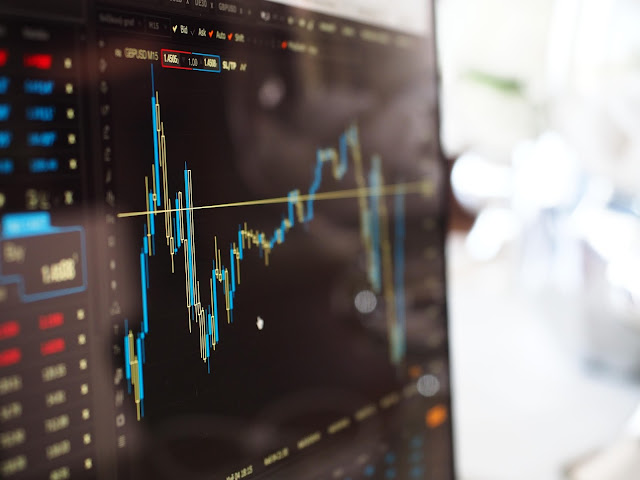"Bubble = a rally that I missed" -- Burnett Tabrum, Portfolio Manager. ref :- "In 2017, Investors Can Either Buy Bubbles of Be Left Far Behind" , Bloomberg Markets
Mr Tabrum's pithy message may be over two years old, but it
retains all its self-mocking wisdom and has seldom been more appropriate. If it
smacks a little of bitter self-recrimination at missed opportunities, well
..... we can surely forgive him that. Who amongst us hasn't been there ?
The degree may depend on the nature of the portfolio you're
managing, but caution in investment decisions is never a BAD thing. More than
that, in terms of weighing up risk/reward ratios we would argue that it's
essential. It's just that one's got take care that caution doesn't become
all-consuming and hamstrings the decision-making process. Those who naturally
distrust markets that have already made huge gains (with or without the
fundamental evidence to back them up), who believe that once the purchase of
any soaring instrument can be termed as "getting aboard the
bandwagon" then it's already too late to do so, are probably leopards who
will never change their spots.
Being prone to missing a few boats ourselves over the years, we
can totally understand that. But it is both interesting and instructive to look
at what might have been, and Bloomberg take a look at what they call the
"Bubblicious" portfolio that is stuffed full of things that everyone
insisted just couldn't keep on going up. Now this is a HYPOTHETICAL portfolio,
and the word "hypothetical" tells us all we need to know about how
easy it is to pick big winners in hindsight -- nobody mentioned
this portfolio to us back on Jan 1st. One might question therefore whether it's
a worthwhile exercise to examine the performance of a collection of assets that
realistically most managers would have considered far too risky.
We would argue that it is worthwhile, both because it teaches us
about assets we might not normally at least consider but probably should, and
because it highlights possible changes in market methodology and practice that
we should be aware of. More specifically, it might make us ask the question, as
a number of top Wall St firms are, of whether it's possible that the
"momentum mania" so prevalent in today's markets signals the demise
of "value" investing. Looking for the best value in a purchase will
surely never go out of fashion, but will the obvious adage "Buy low, Sell
high" morph into "Buy high, Sell even higher" ? There are those
that believe that the era of ultra-low rates and abundant liquidity means that
it might.
The Bubblicious portfolio, comprised of assets that allegedly were
already over-inflated, has made (or more accurately, would have made) over 120%
so far in 2017. By way of comparison, the S&P 500 is up just less than 15%
YTD. Bearing mind that any one of these investments might be too much of a
flyer for most managers to take, never mind backing all of them, here they are
:
Sunac China Holdings Ltd :- The epitome of an
aggressive, highly-leveraged and acquisitive property company operating in the
frenzied world of Chinese real estate.
Tencent Holdings Ltd :- Up 2,600% in a decade,
this massive Chinese tech company operates in just about all areas of that
field
Tesla Inc. and Netflix Inc. :- Two US tech companies
branded as potential bubbles by certain fund managers
VelocityShares Daily Inverse VIX Short-Term ETN :-
An exchange-traded note that acts as a vehicle for "shorting"
volatility .... in other words, betting that stock markets will remain serenely
calm
Bitcoin Investment Trust :- A cryptocurrency fund
that trades at a big premium to its net asset value. Bitcoin itself is up over
700% in 2017, and has been described as a bubble waiting to burst by numerous
investment gurus.
ETF Industry Exposure and Financial Services ETF :-
An ETF holding a basket of firms poised to benefit the most from the explosion
in ETFs -- or if you like, from the explosion in Passive Investing
Long Bonds :- Includes the iShares 20+ Year
Treasury Bond ETF which has attracted $1.8 billion in inflows this year despite
bubble warnings from former Fed Chair Alan Greenspan, German Bunds maturing in
2048, Japanese Bonds maturing in 2050 (known as a "widow maker" for
those who vainly attempt to short-sell them), and the "infamous"
Argentinian century bond.
Be honest, how many of these fellas would you have bought ? .....
Or perhaps you did buy some, in which case a hearty "Well done" to
you. The reference to the growth of passive investing is interesting, and
plainly the move to trend-following instruments and questions about the merits
of value stock-picking are related. But to be frank, whether it's the nature of
the instruments or the giddy purchase prices that have to paid, these kinds of
investments will always remain an anathema to many. Those guys would happily
admit that their more conservative trading decisions are never likely to reap
such spectacular rewards, but at least they can sleep at night.



No comments